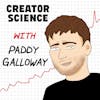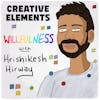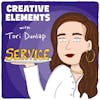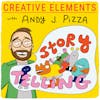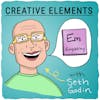
#151: Nathan Barry of ConvertKit — Acquiring SparkLoop and turning email into multiplayer mode with the Creator Network
Play EpisodeNathan Barry returns to talk about the Creator Network (and their most recent acquisition)
EPISODE DESCRIPTION
Nathan Barry is a creator, author, speaker, designer, and the founder of ConvertKit. ConvertKit powers the audiences for creators like Gretchen Rubin, Chris Guillebeau, Pat Flynn, Tim Ferriss, Carrie-Anne Moss, and Tim McGraw.
If you're not familiar with Nathan, he was a guest on episode number 96 of this show a little more than a year ago.
Nathan and I caught up about a month ago at CEX, the creator economy expo in Cleveland and there is some big news. ConvertKit acquired Sparkloop.
In this episode, you’ll learn:
- What you can expect from the creator network
- The acquisition of Sparkloop
- And how to build a flywheel as a creator
Full transcript and show notes
Follow Nathan on Twitter / YouTube
***
CONNECT
🙏 Make a guest or mailbag request
📝 Check out our curated Playlists
***
SPONSORS
💼 View all sponsors and offers
***
SAY THANKS
💜 Leave a review on Apple Podcasts
Learn more about your ad choices. Visit megaphone.fm/adchoices
Jay Clouse [00:00:14]:
Hello, my friend. Welcome back to another episode of creator science. This is an exciting, exciting episode. I am joined once again by Nathan Barry, the founder and CEO of ConvertKit now, if you're not familiar with Nathan, he was a guest on episode number 96 of this show a little more than a year ago. Nathan and I caught up about a month ago at CEX, the creator economy expo in Cleveland, where we recorded this conversation that you're about to hear. I am a huge, huge fan and advocate for ConvertKit. ConvertKit is what I use to send my creator science newsletter. I believe it's the best email service provider, the best email marketing platform on the planet. I'm even a part of the ConvertKit sponsor network. They handle the ads for my newsletter. And the biggest reason I love ConvertKit is because I think they just understand creators. So, so well, our mission as a.
Nathan Barry [00:01:06]:
Company is that we exist to help creators earn a living. And so how do we switch ConverKit from something that you pay for to where we pay you? We're trying to build the best place to earn a living online as a creator. And so it'll just be anything else that we can layer on in that experience because we want it where you're just, like, pay for ConvertKit. I guess I did, but they actually just sent me eight grand this month.
Jay Clouse [00:01:29]:
For a long time, I have been using ConvertKit in conjunction with a tool called Sparkloop. Sparkloop began as an email referral tool, and I began using it for their email recommendations tool. That was a feature called upscribe. Now, recently, ConvertKit rolled out what they're calling the creator network. And the first feature of that creator network is email recommendations. Now, I had a hard time deciding which of these two tools am I going to use? But this conversation with Nathan at CEX a month ago put that question to rest. And we have a big, big announcement, a scoop. Here something that was just announced on stage at craft and Commerce in Boise, Idaho. Here's the big news.
Nathan Barry [00:02:10]:
We actually acquired Sparkloop. They integrate with every major email provider. And so what that means is if I'm trying to earn a living on ConverKit and I'm looking for who I can recommend, it's not just convercate newsletters. It could be the hustle. It could be MarketBeat, any of these big publications. You're getting paid so early in your creator journey that this is fantastic. So when we saw that, we were, like, immediately calling up Louis and Manuel on the Sparkloop founders and saying, like, hey, we need Sparkloop to be a part of ConvertKit. We want to acquire you guys. And it took a few months to.
Jay Clouse [00:02:46]:
Make the deal happen, but the deal is done. Sparkloop is part of ConvertKit now, and I am very, very excited about it.
Jay Clouse [00:02:53]:
I'm very excited about the future of.
Jay Clouse [00:02:55]:
Email and what Nathan describes as multiplayer mode is what they're enabling at ConvertKit with email. And if you know my work and what I talk about, email has historically not been a discovery platform. It's been very difficult to get people to find your email newsletter. Well, with what ConvertKit is doing with the creator network, it's a very bright future. In this whole conversation that we had here at CEX, we're going to cover exactly what you can expect from the creator network, what it looks and feels like. And if you go to the show notes, there's a link for you to start using the ConvertKit creator network right now. As I said a moment ago, after this conversation, I switched to the ConvertKit creator network and in just about a month, I picked up an extra 2000 email subscribers from recommendations. I have nearly 60 different creators recommending creator science right now. I would love for you to recommend creator science if you join the ConvertKit creator network and it's become the number one source of new subscribers for creator science. So we cover the entire product here in this episode. We talk about the acquisition of Sparkloop, and we also talk about how to build a flywheel as a creator.
Nathan Barry [00:04:00]:
I would love to hear what you.
Jay Clouse [00:04:01]:
Think about this episode as you're listening.
Jay Clouse [00:04:03]:
You can find me on Twitter or Instagram at J klaus tweet at me, say hello, let me know that you're listening. And now let's get to that full conversation with Nathan Barry from CEX.
Jay Clouse [00:04:18]:
Okay, let's talk about the creator network.
Nathan Barry [00:04:20]:
Yeah.
Jay Clouse [00:04:21]:
Which is publicly available now. I want to talk literally the user experience here in a second, but let's just start with the creator network itself. I want to know at what point you guys decided to pull the trigger and say, we're going to take this on as a platform, right? Because it seems like a really large feature set and capability to build out.
Nathan Barry [00:04:40]:
Yeah, well, it's a fundamental shift in how ConvertKit and how email works, because if you think about everything that we've been doing as creators in email, it's all single player modes. It's all, this is what I'm doing. If you're on MailChimp and I'm on Convertkid and someone else is on AWeber, it doesn't matter because we could all be in a mastermind group and we'll be like, oh, I can't use the same automation across each of our accounts. But it doesn't really matter. It's all single player. And the creator network is a shift in thinking of like, okay, nothing about what we do as creators is single player except for our email clients, which is kind of weird. We're talking about what we're doing on Social, we're in Masterminds together, we're at conferences, like all of that. It matters who we're working with, who we're partnering with, but there's not software built around that. And so the creator network is this idea of, okay, what if email switches and it's all multiplayer experience and it's all, how do we partner with other creators in order to grow faster and do more things? So the very first feature that we have as the creator network is recommendations. And so that's where it's something that spark Loop really popularized, where when someone subscribes to your list, you can come in, it pops up and says, hey, thanks so much for subscribing. Also check out these other creators that you should follow. It ends up driving 50 to sometimes even 100% faster growth.
Jay Clouse [00:06:11]:
Wild.
Nathan Barry [00:06:11]:
I mean, the stats are wild. You know this from being in groups that are driving a lot of growth. And so, yeah, that's the first feature and that's how it works. And it's really taking this idea that we tell every creator, okay, if you want to grow, meet other creators, partner with them, do swaps with them, it's like, okay, let's take those individual activities and let's systematize it.
Jay Clouse [00:06:33]:
Yes, okay. This is already opening up new doors for me because now it's becoming much more clear. While you're calling this the creator network as opposed to email recommendations.
Nathan Barry [00:06:41]:
Right.
Jay Clouse [00:06:41]:
It sounds like you're alluding to other future ways to make this a multiplayer game, which I like because, yeah, historically email is the strategy that everyone wants is like the backbone of their business, but there's no incentivized or even mechanized way to have organic discoverability or growth in that way. Talk to me about the literal user experience of being on the creator network from the subscriber side.
Nathan Barry [00:07:10]:
So basically what it is, it's the same subscription process that you'd go through, right? Because ConverKit has we've got our opt in forms installed on, I don't know, 40, 50,000 websites at this point. And so you're opting in like normal, and you could be looking to get the free download or join a newsletter or whatever the offer is. And then after that, it shows a form and says, hey, thanks for subscribing. Here's the other creators that I recommend.
Jay Clouse [00:07:35]:
So form is in a modal that.
Nathan Barry [00:07:37]:
Pops up on a modal that pops up. And so an example would be like James Clear, saw Hill Bloom, Ryan Holiday and Tim Ferriss are all in a cohort together.
Jay Clouse [00:07:47]:
Damn, how do I get into that?
Nathan Barry [00:07:49]:
Yeah, it's next level. So if you signed up on Saw Hillbloom's newsletter, it's going to recommend the other three, right? You sign up on Ryan Holiday's Daily.
Jay Clouse [00:08:01]:
Checkboxes next to checkboxes.
Nathan Barry [00:08:03]:
Yeah. And then you hit subscribe. It adds you to their lists as well. You can customize the email that someone gets from you, right? So you know that someone came in. Maybe. I know that someone signed up for my newsletter as a creator through my Twitter opt in form, and they're getting one email sequence, but I know that someone else came in because they signed up for you and you recommended me. And so I could have a different email and say, like, I might need to introduce myself a little more.
Jay Clouse [00:08:31]:
This is a pain point that I've currently dealt with, with subscribe, which is possible for me to work through that.
Nathan Barry [00:08:38]:
But it's another thing to implement.
Jay Clouse [00:08:41]:
So you're saying literally, the tool is already built so that the form detects which publication, which newsletter recommended me so I can make a bespoke welcome series.
Nathan Barry [00:08:53]:
Yeah. So right now where we're at is you can customize it based on, hey, you came from a recommendation, or you signed up for me directly.
Jay Clouse [00:09:02]:
Okay.
Nathan Barry [00:09:02]:
And then what we will be building out is the functionality where I could change it and say, hey, Jay recommended that you sign up for my newsletter. And here's a photo of me and Jay. We go way back and we took this, we were recording at CEX. So you can bridge that gap. Here's why I love Jay's work, here's why he loves me. And then you can drop someone into a more traditional sequence rather than somebody like, wait, Nathan, how did I get on your list? Or having that confusion?
Jay Clouse [00:09:32]:
Yeah, I do want to talk about that too, because how cynical of a person are you?
Nathan Barry [00:09:38]:
It depends.
Jay Clouse [00:09:39]:
Okay. Middle of the road, I find that I increasingly have, like, a cynical voice in my head that makes me question things sometimes. And the cynical part of my mind when it comes to newsletter recommendations, generally not a convertible thing, just generally is, okay, how many people are recognizing that they're signing up for multiple newsletters? How many newsletters am I recommending? And then is the immediate subscribe experience. I just got five welcome emails.
Nathan Barry [00:10:06]:
Right?
Jay Clouse [00:10:06]:
So how do you guys think about that? Because what I would actually love to do is after I make a or after someone has referred to me from another newsletter, I would like to delay my welcome email a little bit, but like, minutes, not immediately, not an hour. I would like to stagger it a little bit because I imagine that subscriber experience, especially if they didn't realize what they're doing, they're like, yeah, I'll accept the terms and conditions could be a little overwhelming.
Lewis Howe [00:10:34]:
Yeah.
Nathan Barry [00:10:35]:
So I think that as we're thinking about building out this functionality, I was wondering, is this going to be something that's a trend or a gimmick? And it is going to spike, and then after a while, it ends up being that consumers get sick of it or something else. And really it comes down to what you're hinting at, which is how good of an experience can you make it?
Jay Clouse [00:10:57]:
Yes.
Nathan Barry [00:10:58]:
The terrible experience is I signed up for five newsletters. I didn't realize what I was signing up for. And then I started getting daily emails from every newsletter and I'm just like, what even happened? I don't know who you are.
Jay Clouse [00:11:12]:
All of that.
Nathan Barry [00:11:12]:
That's one way that this could go. I think what smart creators are going to do is they're going to be thinking about, okay, how can we make this a good like, if we're in a mastermind group together and we're saying, hey, let's all grow faster by partnering together. And we're already helping each other out with Twitter replies and LinkedIn and all of that. And so now we're saying, hey, how do we all grow faster on the back end as well? Well, then we're going to be thinking about it. I'm going to be like, hey, Jay, on your welcome sequence, why don't you delay that a day? Why don't we? Let's personalize it. Let's take a photo together. Let's have the first thing that we link to in that be a podcast episode that you and I did together.
Jay Clouse [00:11:51]:
Yes. This is the bespoke sequence that I want to create, for sure.
Nathan Barry [00:11:55]:
Because then it's like, hey, we're not like, oh, I guess I'll recommend Jay and click click and move on, right? It's like, oh, how do I make this a real partnership? Because now we've done a few podcast episodes together. It's not just the photo, it's what we like. Here's where we overlap. Here's the things you were just in your talk. You're talking about tiered pricing for memberships, right? I'm a huge tiered pricing fan. We could nerd out on that for a long time. And so that's the sort of thing where we could make a great sequence. It might only be two or three.
Jay Clouse [00:12:28]:
Emails before interested, but it's not a welcome sequence. Well, it is, but it's not like, hey, welcome. It's like, I know something about you. Here's a very concrete piece of value I can deliver you based on what I know about you.
Nathan Barry [00:12:40]:
Yeah.
Nathan Barry [00:12:40]:
And so how do you bridge that handoff? If my whole job is to take someone who's a fan of me and turn them into a fan of you? There's a lot of things that I can do. Not just here's why I enjoy Jay's work, but also here's the episode that we did together. We can bridge that gap in so many ways. So, like anything, there's going to be some really terrible implementations and then there's going to be people who are making it a great bespoke experience and absolutely nailing it.
Jay Clouse [00:13:07]:
Yeah. Okay. Yeah. Because that's the cynical thing I think of sometimes, is like, this is a wonderful time to be doing email recommendations. How does this not go to zero for everybody?
Nathan Barry [00:13:17]:
Right?
Jay Clouse [00:13:18]:
Because I can see that. So when you talk to creators who are already on the network and they're doing this, do they have any competitive fear of saying, like, I actually don't want my subscribers to subscribe to five other newsletters? Do people worry about that, or is that a non issue?
Nathan Barry [00:13:34]:
Yeah, well, I think the first thing is just because a tool lets you recommend five newsletters at once doesn't mean you should.
Jay Clouse [00:13:41]:
Right.
Nathan Barry [00:13:42]:
And so if we're trying to make this a great subscriber experience, recommending one other newsletter is probably not enough. Right. But I think three is about the perfect number. And so one thing that Creator Network has built in is the ability to recommend as many as you want, as many as you want, and select how many should be shown to a subscriber at any time.
Jay Clouse [00:14:04]:
Okay.
Nathan Barry [00:14:04]:
And then it'll round robin through that.
Jay Clouse [00:14:07]:
I like that.
Nathan Barry [00:14:07]:
So, for example, I'm currently recommending seven newsletters, but I'm only ever showing three.
Jay Clouse [00:14:11]:
At a time, and it's randomized. Or do you also set the schedule of how frequently it cycles through?
Nathan Barry [00:14:16]:
Right now, it rotates through evenly.
Jay Clouse [00:14:19]:
Okay.
Nathan Barry [00:14:19]:
But we're building the functionality where you can actually choose. You would say, like, hey, maybe in this case, I want to recommend J all of the time, and I want to rotate through these other four.
Jay Clouse [00:14:30]:
Is that fine tuned?
Nathan Barry [00:14:32]:
That's where we're headed.
Jay Clouse [00:14:33]:
Interesting.
Nathan Barry [00:14:33]:
I like that because it might be take an example where let's say you're getting 100 new subscribers a day, and I'm getting 25 new subscribers a day. If we partner, that's a fairly lopsided partnership. And on one hand, we might be fine with that because of other value or just friends, but we kind of want a way that we could even that out. And so you could set it where here's your small creator partnerships that rotate through a slot, and they're each getting basically 25% time, whereas you might be partnered with someone who's at your level or a little bit bigger, and you're like, hey, I need to promote this person all the time. And so it lets you do swaps and partnerships with people where it's not about total list size, it's about list growth.
Jay Clouse [00:15:17]:
Yeah, I think it's brilliant because that's what happens in podcasting now. If you're using a platform like Megaphone, like I am, and you want to do a cross promotional with another show, of course you want to find roughly the same size, but you can actually meter it and say, I'm giving this person 100,000 impressions and they're doing the same, and they may be able to get me 100,000 impressions in a day. It may take me a month. But I didn't know you guys were doing that, and I love that as an approach.
Jay Clouse [00:15:43]:
After a quick break, Nathan and I talk about how you can get recommended by other creators on the Creator Network. So stick around. We'll be right back. And now back to my conversation with Nathan Barry, the founder and CEO of ConvertKit.
Jay Clouse [00:15:57]:
Talk to me then about if I'm a creator and I want to join the creator Network, but I don't have a mastermind group already. I'm not sure who to partner with. What's that experience look like on ConvertKit?
Nathan Barry [00:16:06]:
Yeah. So it's a full directory inside of ConvertKit where you can browse and look by category and see, okay, I'm a fitness creator. Who else is in this space that I would want to recommend? If you recommend someone, it doesn't send them a notification. As soon as you're recommending them. It lets them know as soon as you've sent them subscribers.
Jay Clouse [00:16:27]:
Okay.
Nathan Barry [00:16:28]:
So it's interesting, right?
Jay Clouse [00:16:29]:
Helping a better experience.
Nathan Barry [00:16:30]:
Yeah. So helping Ryan Holiday, for example, set this up. He's going through he's got his group that he is recommending. Right. And that was they're all friends separately. That was a conversation like, hey, let's put all of this together. But then now there's a lot of people that have found Daily Stoic, his newsletter in the directory. And like, oh, like Ali Abdahl, for example. They've never had a conversation that I know of.
Jay Clouse [00:16:53]:
And that actually shines nicely on the person recommending too. You're taste making, in a way, the publications that you're recommending. So that sends some sort of signal of your taste. And some people might even read into it and be like, oh, wow, he's recommending Ryan Holiday. Maybe he's friends with Ryan Holiday.
Nathan Barry [00:17:09]:
Right? Yeah. But I think it's a really interesting way to get on another creator's roadmap.
Jay Clouse [00:17:15]:
Oh, yeah. Radar.
Nathan Barry [00:17:16]:
Radar, yeah. Because if you think about, like, in Ollie's case, he's growing quite well. He just went on and said, who are the creators that I like? He browses directory. Oh, him, him, him. There we go. And then he's got other creators that he's working on swaps with. But in that case, Ryan's like, who's this guy that sent me 400 subscribers? It's not like, oh, yeah, I had a casual shout out on Twitter, enjoyed this podcast episode. That's one way to get on someone's radar. But when you're like, totally, you sent me all these what a driver. Yeah. And someone's like thank you. And so then you might get into one of those situations where especially as a big reason that we want this granular functionality. So you could say, here's who I'm doing real partnerships with, where we're on the same level. And then here's my pay it forward slot where someone like a James Clear or a Saw Hill Bloom who are getting 2000, 3000 new subscribers a day could say like, it's like the new and noteworthy.
Jay Clouse [00:18:16]:
Oh, my God.
Nathan Barry [00:18:16]:
Right? And here are the creators that I just think are great.
Jay Clouse [00:18:19]:
That's awesome.
Nathan Barry [00:18:20]:
And you might rotate five or six through that slot because if you send them 5100, 200 subscribers, especially if you.
Jay Clouse [00:18:27]:
Have the back end build out, where you understand how a subscriber becomes a customer in some way.
Nathan Barry [00:18:34]:
Yeah.
Nathan Barry [00:18:35]:
And so there's so many things about growing as a creator that we know of, going to the events, meet people, build these relationships, pay it forward. I can think of so many people that I'm only where I'm at now because of creators like Chris Gillibo, Ryan Holiday. I mean, there's Brennan dunn. There's so many people. And so it's like, wait, but we're software. I'm a software guy. How do I productize this and make it so that the product is actually encouraging these connections?
Jay Clouse [00:19:08]:
What's the reporting like in the back end?
Nathan Barry [00:19:10]:
Yeah. So it tells you exactly who's sending you how many subscribers, what the conversion rate is. So if that modal pops up okay, who conversion rate by referral. Yeah, exactly.
Jay Clouse [00:19:20]:
Wow.
Nathan Barry [00:19:21]:
And so you could see, okay, Saw Hillbloom, for example, has the highest conversion rate that I've ever seen, where when he's recommending someone, there's like a 44% chance that they so when he recommends James Clear, 44% of people that see that modal are like, yes, I want I want to see that. I think it's because his audience is just hyper engaged and he's so good at driving people from social. But then other times you might see like, okay, I'm recommending these four creators, and three of them are getting a 30% conversion rate and this one's getting a 20% conversion rate. I wonder why. Then we can dig in. Okay, maybe there's not a good hook. Like, they're not explaining what their newsletter is. Well, it's not compelling. There's not name recognition. So you can tweak that.
Jay Clouse [00:20:05]:
I like that you're sharing numbers in like, the 2030 40% range. Because the cynical part of me that was tapping into a little bit ago was like, I bet like 90 plus percent of people subscribe to all the recommendations because they're not paying attention to those clicking buttons. It makes me glad to hear that. It sounds like initially you're seeing people have awareness and discernment for themselves.
Lewis Howe [00:20:24]:
Yeah.
Nathan Barry [00:20:24]:
And I think the more as we lay around functionality to be able to customize all the copy, like, here's why I'm recommending this person and make that a bespoke experience. The higher the conversion rate will be and just the more intentional everyone will be with it.
Jay Clouse [00:20:39]:
Yeah. So I was formerly on Upscribe. Can we share the big news?
Nathan Barry [00:20:44]:
Yeah. So when we rolled this out, people are like, oh, are you competing with Sparkloop now? I thought you had a partnership. And we've sort of had this interesting dynamic for the last few months where people are asking questions and we're like, well, I guess the first thing to talk about is with Upscribe. Upscribe is a feature of Sparkloop that does this and lets you integrate with any email provider. Their ultimate play is something called the partner network. And that is where you can do this through paid advertising. Right. So if I'm a creator and I want to grow my audience and I know what my revenue per subscriber is, I know that my funnel, if I put engaged subscribers in here, I'm going to promote my membership or my course or whatever else, and I'm going to make a certain return per subscriber. So then typically, I'm going out to Instagram, Facebook, LinkedIn, and I'm running ads because I know, okay, if I spend $1,000, I can make 2000 back over this time period.
Jay Clouse [00:21:42]:
Can I give a very specific example of this just to break it down for folks? So, Justin Moore, friend of mine, also was using Upscribe by Sparkloop, we had a handshake agreement that we're going to recommend each other. Then he started running ads. He was paying somewhere like $3 per subscriber. He was recommending publications in Upscribe that were paying $2, $3 per subscriber each. So he's actually netting typically $3 ish per subscriber for the paid ads that he is running. And as someone he's recommending, I'm getting the benefit of those paid ads as well. So if I was also running paid ads, we could effectively cut our acquisition cost in half. That's what was so exciting about this.
Nathan Barry [00:22:20]:
Yeah.
Nathan Barry [00:22:20]:
And so if you think about it from the creative perspective, I'm used to going out and paying the big tech companies, and now in this case, I can go on the partner network and say, okay, I will pay $2 per engaged subscriber that any creator sends me. And what I love about this is, instead of paying Mark Zuckerberg, I'm now paying Jay Klaus. Right.
Jay Clouse [00:22:39]:
Totally.
Nathan Barry [00:22:39]:
And so it's like, let's keep this money in our ecosystem. Subsahil Bloom is a great example. He has built this amazing flywheel of driving subscriber growth for his newsletter, where he's got the new subscribers coming in, nurturing them on his automation and his email list. Then he has sponsorships through the converted sponsor network, and he's taking 100% of the money he makes from that and spending it on the partner network to grow faster, which makes his email list bigger, which means that he sells more sponsorships, which means he has more money totally to spend on. So this flywheel just accelerates and goes faster and faster. And he's now adding, I think, 50 to 70,000 subscribers a month.
Jay Clouse [00:23:20]:
That's insane. That's crazy. It's completely wild.
Nathan Barry [00:23:24]:
And the flywheel is getting faster and faster. And so in this for Sparkloop, Upscribe is not the core feature. Upscribe is the real estate that enables the partner network. And so what they were looking to do is partner with more email companies like ConverKit and really roll this out and say, hey, how can we make this available to your entire customer base? And so people were like, oh, are you competing with Sparkloop now? I thought you guys invested in them. I thought you had a partnership. And it's like, oh, no, we're accelerating their whole plan. The other thing in it is that we actually acquired Sparkloop.
Jay Clouse [00:24:02]:
Oh, casual. And also, yeah, we just bought it.
Nathan Barry [00:24:06]:
Yeah. And so our mission as a company is that we exist to help creators earn a living. And we saw what Sparkloop was doing. It's like, this is an amazing way totally. To if you're a creator and you're sponsoring, it's an amazing way to grow your audience faster. You're only paying for engaged subscribers. And if you build an automation funnel and all that, we know very well how to earn more from that. And then as a creator, you can go on there and say, oh, I'm a big Saw Hill Bloom fan. I would love to get paid to recommend his newsletter. And so even if you have five new subscribers a day coming in, you could be recommending Saw Hill or anyone else. And so you can get to the point where you're making 510, $20 a day, and this is before you've made a product. You're getting paid so early in your creator journey that this is fantastic. So when we saw that, we were like, immediately calling up Louis and Manuel on the Sparklift founders and saying, like, hey, we need Sparklift to be a part of ConvertKit. We want to acquire you guys. And it took a few months to make the deal happen.
Jay Clouse [00:25:12]:
Yeah, well, it makes me happy as a creator using both, because Louis Manuel built an amazing product. Love their team. Love the ConvertKit product. Love the ConvertKit team. And now I'd have to make a choice.
Nathan Barry [00:25:23]:
It's all one thing. Another thing that's amazing about it is they've built out all of this functionality. Well, first, because of their referral product.
Jay Clouse [00:25:32]:
That they've had for years, we haven't even talked about that.
Nathan Barry [00:25:33]:
They integrate with every major email provider. And so what that means is if I'm trying to earn a living on ConverKit and I'm looking for who I can recommend, it's not just ConverKit newsletters. It could be the Hustle, it could be MarketBeat, any of these big publications that are using, like, enterprise level.
Jay Clouse [00:25:53]:
So you'll continue to let them go outside?
Jay Clouse [00:25:55]:
Absolutely.
Nathan Barry [00:25:56]:
That's awesome, because we're saying, as a creator, how can you have the biggest option at the highest cost per lead that you could recommend so you can maximize earnings? And because Sparkloop integrates with all of these, it doesn't matter. As a sponsor, you could be on any platform and get access to all this. So it's really about building a really big, high quality network as fast as possible. And then the other thing is that because there's a direct integration, as a sponsor, you only have to pay for the engaged subscribers. And so that's a huge difference. Whereas if you're advertising on Facebook or another traditional channel, you're paying for CPMs, basically views, then you've got a conversion rate and you're working your way down and you're trying to say, okay, ultimately, if I spend this much money, I'm getting to $3 per subscriber. But you have no, like, then you're, you know, weeks down the road, you're tracking, were they actually engaged? Where they're high quality? And so in this case, you're only paying for the engaged subscribers.
Jay Clouse [00:26:54]:
Let's talk about that. With the data that you have so far, you guys rate subscribers on a one through five scale. For the folks on the creator network who have received subscribers, how is that average subscriber rating looking so far?
Nathan Barry [00:27:08]:
Yeah, I would say so. I guess the first thing to know when someone subscribes to your list, if you get 1000 new subscribers, day one is when they're going to have. The highest average open rate, and you're going to see that gradually decline. So if you look at the stats on a welcome sequence, it might start email number one at 75%, 70%, and then it might, by the end of the sequence, say, drop down to 45%. And that would be pretty normal numbers to see. And so if you keep in mind that's just that someone's like, really excited, and then they get busy with life as time goes on. And so you're going to see kind of a similar curve. What we've seen on the Partner Network is that an organic subscriber, if you think of those numbers for organic subscribers, a paid subscriber or recommended subscriber is going to be about 20% lower than that.
Jay Clouse [00:27:59]:
But you're putting paid and recommended as a similar quality together. Okay. Yeah.
Nathan Barry [00:28:03]:
At least so far we'll see how it trends out. This is all still really new because.
Jay Clouse [00:28:08]:
A paid subscriber is like a soft endorsement. It kind of feels like a recommendation.
Nathan Barry [00:28:11]:
Absolutely. And it should be, right. If you're just browsing, you're saying, hey, who's paying the highest per subscriber? I'm going to pick that out and go from there. You want to do it based on who you actually recommend because your integrity is online. This is an endorsement. You're just not just like, oh, someone said they pay $8 subscriber, I'll throw them in my recommendations. It's like, no, you're picking someone that you would actually recommend, and you like their content.
Jay Clouse [00:28:38]:
Yeah. After a quick break, Nathan and I talk about how you can build a flywheel to grow much, much faster. So stick around. We'll be right back. And now back to the show.
Jay Clouse [00:28:50]:
I want to go back to the Saw Hill story you're telling a second ago because I think what's brilliant about his growth strategy, he has a background in investing.
Nathan Barry [00:28:58]:
He does.
Jay Clouse [00:28:58]:
He's a creator, but he's even treating his creator business like he's making investments. He looks at, okay, what's the return on bringing these in? You can see he's even structuring his business like an investment. It's wide open. Can you talk about how creators can think more like an investor as opposed to just like a maker of content?
Nathan Barry [00:29:20]:
Yeah. So something that doesn't get talked about enough is flywheels as a creator. And so Jim Collins in his book, Good to Great theorizes, and it's a book that probably every investor has read because it's about how are these companies building up to this level, like, how are truly great companies built? And he theorizes that all of these great companies have a flywheel. And so a flywheel is where, if you think about, like, a water pump, it might be in a campsite or something. It's this big metal handle, and you're pumping it up and down. It's this individual action that like the same amount of force to pump it down and then up. And it does not get easier with time. It's a consistent amount of effort. Back in 2008, I got to go on this trip to Lesotho, which is the little landlocked country inside of South Africa. And we were doing some public works projects at this orphanage and we drilled a well, and because electricity was not reliable there, we actually installed a flywheel on top of this well. And now what a flywheel is, it's this big steel wheel that sits on top of the well.
Jay Clouse [00:30:28]:
It's like a merrygor round.
Nathan Barry [00:30:29]:
Yeah, it's oriented vertically.
Jay Clouse [00:30:31]:
Okay.
Nathan Barry [00:30:32]:
In this case. And the action of that wheel turning pumps water. It runs the pump. And so when it started, when I tried to start pushing this, it was really hard. And a friend came over and he pushed it. And together we got the spinning. And the first rotation was very difficult and the second rotation was easier. By the third or fourth, it's building momentum. And my friend stops helping later. I'm spinning with one hand, and by the time it's going, it's pumping water very, very well and I could spin it with one finger. And so a flywheel is basically where it's taking the individual actions, turning them into a sequence that gets easier with time. So there's three key rules of a flywheel that you have to understand. One is that you have to take individual activities and turn them into where they feed one into the other in a circular motion. The second thing is every rotation of the flywheel should be easier than the previous rotation. And third is each rotation should produce more than the previous rotation. Those are simple rules, but when you put them together, the results are insane. So a couple of quick examples. If we have a new blog post comes out, new podcasts, and you're like, I guess I should promote it here or here, you could actually have a system where you're like, oh, this is a flywheel that I use for promoting a new podcast episode. And so, you know, every time, this is what I'm going to do. And so you're taking a bunch of separate marketing activities and you're feeding them one into the other. Another example would be on rule number two of making it easier, like something that we all do is write a weekly newsletter. The content is usually the thing powering the flywheel. Well, it can be hard to come up with content ideas week in and week out. And so if we think about like, Saw Hill, Bloom's Flywheel, the core engine in that is a really high quality newsletter that goes out twice a week, right? That's what people are actually signing up for, that he can then sell sponsorships in that drives revenue and all of that. So the content being good is what matters most. So how do we make that easier? Well, in your welcome sequence, add a question that says, hey, what's your biggest frustration with learning whatever we're teaching, right? With learning how to build and grow a membership with learning how to design iOS apps. Like Brennan Dunn had this question with building a freelancing business, and you say, Hit reply and let me know. Well, all of those replies go into a label in Gmail. You could have Zapier put it into a spreadsheet if you wanted. And so now what you're doing is when you're like, okay, it's Monday at 05:00 p.m.. I got an email. It's got to go out on Tuesday. What should I write? Well, you go in there, you have your readers telling you, these are my frustrations. And then you get to dive in and say, I'm going to answer this one. And that's writing, that content. Now, that content helps you get more subscribers, which then puts more people through the funnel. There's more people giving you content ideas, which will help you get more subscribers. And so that hits rule number two of every rotation of the flywheel gets easier with time. And then we already touched on this with Tha Hill, but rule number three is each rotation should produce more than the last one. And so that's where if you think about early on in his flywheel, if he's got 50,000 subscribers, he can sell sponsorships for a certain amount, which produces a certain amount of sponsorship revenue, which then he can acquire subscribers he can reinvest. So early on, say, a one month rotation, that flywheel produced 5000 subscribers. Now a one month rotation, that flywheel was producing more like 50,000 subscribers. And that's going to keep accelerating because he's going, I'm an investor.
Jay Clouse [00:34:12]:
Totally.
Nathan Barry [00:34:12]:
I'm taking all of my profits here and I'm reinvesting them tax free. Right. Because it's a business expense into growing faster. Because his goal is, how do I get to a million subscribers? Absolutely as fast as possible. And so he has designed flywheels around.
Jay Clouse [00:34:26]:
That once you see this and you understand it, you really start to see it everywhere. And sometimes it can be like I mean, it's a beautiful and frustrating thing at the same time. If you listen to Lewis Howe's podcast, School of Greatness for a long time, he's been really good at like at the beginning of the show, he says, and I want to read this week's review of the Week from Apple podcast. This person said this nice thing.
Lewis Howe [00:34:46]:
I give a shout out to today's Fan of the Week from Slasher, who said, I'm a daily listener of the show, and I've yet to find an episode I don't enjoy. From finance to health, I always have a new skill to add to my life. And I truly feel like Lewis and his guests are helping me become the person I've always wanted to be. So, Slasher, thank you so much for being a part of this. And thank you for leaving the review and being the Fan of the Week this week. And if you want a chance to be shouted out on the podcast, just head over to Apple podcast, leave us a review for your chance to be shouted out on the podcast in the future.
Jay Clouse [00:35:17]:
That drives people to leave a review, that drives them up the charts, that gets more listeners who hear that he reads their reviews, they leave a review. And there's just beautiful, elegant flywheels like that all over the place. And as a creator, I feel like a lot of times it feels like you're riding a bicycle in first gear on Flatland, and it's just like, man, I'm pedaling super hard and I'm not getting that far. And these help you feel like, okay, I'm moving in third gear, but I get caught in comparison traps looking up to Saw Hill or Justin Welsh. And the beauty of a flywheel is you realize, oh, I'm not years away from where they're at.
Nathan Barry [00:35:52]:
Right.
Jay Clouse [00:35:53]:
I'm a good flywheel and a couple of months away. You can pick up a lot of ground really quickly as you're sharing. So I think it's a really smart thing to think about and try to design for yourself, because it can really move you forward.
Nathan Barry [00:36:06]:
Yeah. When you think about your business like a system or like a flywheel, then you can say, what do I most need to optimize for in this? And you could say, okay, I want more subscriber growth. Okay, what tweaks? What puzzle pieces can I add to this flywheel that will drive more subscriber growth? It might be a referral program. Okay, how do I get my subscribers to refer more people? It might be a tweak to your content promotion process. Or you could go in and say, okay, I want to drive more revenue. And so it's like, all right, what does my product ladder look like? Oh, I only have a single product that I've ever sold. Wait, that means my biggest fans can only ever pay me $50. There's literally nothing else for them to buy. All right, well, maybe for everyone who bought this, I should add something else. Okay, now my revenue per subscriber went from five dollars to seven dollars. Okay, what should I do with that extra money? Oh, maybe I should invest it into paid advertising on the partner network to grow faster. Interesting. Now it's more people going through it. There's a really great book that's popular in the business circles, but not in the creator circles, called The Emyth Revisited by Michael Gerber. And the point of the entire book is to get business owners to work on their business rather than in their business.
Jay Clouse [00:37:21]:
Totally.
Nathan Barry [00:37:22]:
And this mindset shifts. That where you're able obviously, you're still in it, creating content building relationships, but it lets you step outside and go, okay, how is this running? What is the system? What is the flywheel that this operates on? And how do I make tweaks to it rather than just pedaling away?
Jay Clouse [00:37:39]:
So many creators, they don't treat themselves as a business owner, so the business that they're running treats them as an employee. Right. That's like, the sad reality. People leave their jobs because they're like, I don't want to be an employee anymore. And then they don't step into the role of business owner, and they build a job for themselves. That may take more time, may pay less in the immediate term. So I'm constantly saying, please embrace the fact that you are a business owner. And business owners think about things like flyball. They think about having an investment mindset and where they're putting their time, if not if not their money. So what else if you're able to say what else is coming for the partner network, what else are you thinking about?
Nathan Barry [00:38:19]:
Yeah, we'll have it directly integrated into ConverKit, probably at the time that this goes live, of letting you choose who you want to recommend and get paid for those subscribers later on, we want to make it easy to reinvest everything that you're earning. If you want to say, like, hey, what I sold through Convert Commerce, do I want to withdraw that to my bank account, or do I want to just reinvest that in growth or apply.
Jay Clouse [00:38:45]:
It to my subscription every month?
Nathan Barry [00:38:46]:
Or apply it to my subscription every month? There's a lot of interesting, like, fintech.
Jay Clouse [00:38:51]:
Here'S your invoice, by the way. Here's how much we made you this.
Nathan Barry [00:38:54]:
Month, when that's the whole shift. Right. Our mission as a company is we exist to help creators earn a living. And so how do we switch converk? It from something that you pay for to where we pay you. And so we're trying to build the best place to earn a living online as a creator. And so it'll just be anything else that we can layer on in that experience because we want it where you're just, like, pay for ConverKit. I guess I did, but they actually just sent me eight grand this month. And then on the creator network side, I'm really looking at all the ideas. What does it look like for ConverKit to be multiplayer? And this will take us more time to build out, but let's say you and I are doing a product launch together. Do we launch it in your email list? On my email list, we got similar sized audiences. What's the overlap? Well, I'm really curious about that. Could we share a segment between our accounts that updates and syncs in real time?
Jay Clouse [00:39:49]:
Interesting, right? Yeah.
Nathan Barry [00:39:50]:
Could we do a product launch together where I'm like, hey, I'm going to be promoting your community, so why don't you share a segment? I don't need to see any of the subscribers in it. Just share the segment of everyone who's already a member, and I'll exclude that from my promotional broadcasts. Right. Like, this kind of stuff will take time to build, but that's ConverKit. That's email marketing on multiplayer mode, and.
Jay Clouse [00:40:12]:
You guys do a really good job already of making visual automations, shareable. But there could be a world we're in Spitball territory. There could be a world where you make broadcasts shareable. Right. Like if we're doing a campaign together, instead of me saying, here's this Google Docs link of this horribly formatted thing that Google Docs required me to format in this way, if I could just compose something in my broadcast composer in ConvertKit and say, drop this into your account, even if I have to share that, that could be yeah.
Nathan Barry [00:40:42]:
So the one thing that we're putting live right now actually is the ability to if you design email templates that you can sell those like share and.
Jay Clouse [00:40:54]:
Sell those and sell them make a marketplace.
Nathan Barry [00:40:56]:
Yes, absolutely. Think like notion templates and all that. We're doing the same thing with automations where you can say, hey, as a podcaster, this is the automation that I use. Here's the landing page that I found. Converts the best to get someone from a listener into my free download. Here's the automation and let me sell that through ConvertKit Commerce or give it away for free. And same thing with the email templates where we'll have designers saying, hey, here's the design that I've made. That's awesome.
Jay Clouse [00:41:25]:
That's incredible. Would I be selling that through ConvertKit Commerce?
Nathan Barry [00:41:29]:
Yeah, you could sell it through anything you want, but Convert Ecommerce has it built in natively.
Jay Clouse [00:41:32]:
That's awesome. What do you think about Spotify as an organization? Because you've shared before like you guys had an acquisition offer, you turned it down, you've been public about that. But this is making me think of it feels like what Spotify is doing in audio. You guys are sort of doing an email. Spotify gets a bad rap a lot of times, but honestly, I think they've done a ton for the podcasting ecosystem as they've done. But sounds like you guys are really expanding and almost like vertically integrating the different things creators can do on the platform.
Nathan Barry [00:41:59]:
Yeah, I think it's probably what we're doing that's similar to Spotify is just chasing what builds this whole market and community the most and builds our business and builds their business in the same way. A quick tie for Spotify or tie in there. Dave Alterescue, our chief revenue officer actually led the US. He worked at Spotify in the 2011 on time period. So he led the US launch of Spotify, was there for years. Launched Spotify in Brazil and a bunch of other countries and then ended up leaving, doing other things. Joined a little podcasting startup or they're actually doing Snapchat for audio when he joined, they pivoted into podcasting called Anchor. Yeah, and then built them for two years and then sold them to Spotify. And then he was again at Spotify for a little while and he just joined us because he loves the creator space and musicians and podcasting, I think.
Jay Clouse [00:42:48]:
They have a creator ethos. They do. The bad rap they get is often like you're crowding out other tools or platforms, but it's like but it's because we're making such a good user and creator experience in a lot of ways.
Nathan Barry [00:42:59]:
Now, I think one way that ConverKit and Spotify are different is that we take a very open approach to everything. And this is probably like this is the difference between ConverKit and Substac and others. We have 180 integrations, we have an open API, and we're making that like a long term play that we want to do is let other people build apps inside of ConverKit. And so, like, course platforms could then say, oh, let me get you access to all of our course data inside of the ConverKit email editor. And so rather than making a walled garden, we're saying, hey, let's build as much as we can and whatever the tools the creator wants to use, let them do that. So, like, a good example is we have ConvertKit Commerce, where we're making it easy to sell products. There's a great dashboard inside of your ConvertKit account, but if you're selling on other platforms, we aggregate all that data into the same graph. I do that.
Jay Clouse [00:43:50]:
That's great.
Jay Clouse [00:43:51]:
Yeah.
Nathan Barry [00:43:51]:
So take like Ryan Holiday, for example, with daily stoic. He's got the coins with Stoic phrases. He's got physical books that they're selling. They've got memberships, I think unteachable. I think they've got like a memberful set up. They've got a bunch of things that have set up over the years and it's all aggregated into a single graph. And so we're never going to say like, oh, because you're doing that on a third party, don't do it. Or it has to be this way. It's like, no, whatever's best for you as a creator will make all the data open and keep building integrations.
Jay Clouse [00:44:23]:
It's exciting. I was literally thinking about doing an experiment of just putting existing one off content or products that I have on Gum Road, just because what they've done, they have Discoverability. But it sounds like you guys are building towards the same future, potentially, which is a huge opportunity. Yeah.
Nathan Barry [00:44:41]:
Another one that I want to do that. This is us speculating because software takes a long time to build, but is a marketplace for products sold on ConvertKit Commerce. And then you could browse by having affiliate set up.
Jay Clouse [00:44:58]:
Yes, this is what I was just thinking.
Nathan Barry [00:45:01]:
And so I could go and look through it and be like, okay, I'm a designer. I could go make my own figma course. I don't know that I want to do that, but I've got 10,000 people on this list who has a great figma course totally. That pays a 25% commission. And then I'm like, oh, I don't know who has one. Right. But we pick someone. I think her content is fantastic. Let's pull that in. Let me start recommending it. And then I'm earning getting paid through ConvertKit Commerce since it's one ecosystem, I.
Jay Clouse [00:45:30]:
Love that I hope you guys do that. I hope you expand the ConvertKit commerce sales pages first, but I hope you do that.
Nathan Barry [00:45:37]:
There's so much to build. We're hiring engineers in case anyone's an engineer wants to join.
Jay Clouse [00:45:42]:
Amazing. All right, well, future belongs to the creators. Is there anything else we haven't touched on that I feel like we should have talked about?
Nathan Barry [00:45:48]:
I think we covered it all.
Jay Clouse [00:45:49]:
Okay. We did it. We did it. Awesome. So if you're listening to this and you're compelled, go to creatornetwork.com. If you're already in ConvertKit, it's in your account. If you're not, get it. And, yeah, Nathan, great to hang out, spend some time.
Lewis Howe [00:46:01]:
Yeah.
Nathan Barry [00:46:02]:
Thank you.
Jay Clouse [00:46:08]:
All right, there we have it. The future is bright for email. The future is bright for the ConvertKit creator network.
Jay Clouse [00:46:13]:
I hope you're already using ConvertKit, but.
Jay Clouse [00:46:15]:
If you're not, I truly, truly, truly do recommend it. If you are not using ConvertKit, but you want to start, there is a link in the show notes. Or you can go to creatorscience co ConvertKit. That is my affiliate link. I would very much appreciate you using it. Thanks to Nathan for being on the show. Thank you to Nathan Tonhunter for editing this episode. Thank you to Emily Klaus for making the artworks this episode. And thank you to Brian Skiel for creating our music.
Jay Clouse [00:46:37]:
If you like this episode, you can.
Jay Clouse [00:46:38]:
Tweet at me at j klaus and let me know. And if you really want to say thank you, please leave a review on Apple podcasts or spotify. Thanks for listening, and I'll talk to you next week.
Most Popular Episodes
New to the show? Check out some of our most popular episodes.








